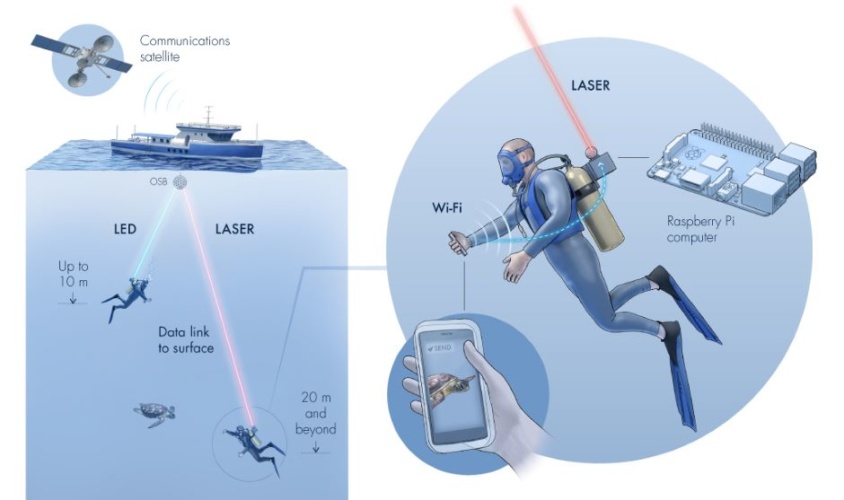
The research, detailed in IEEE Communications Magazine, could enable divers to instantly transmit footage from under the sea to the surface. It would also allow divers to communicate without hand signals.
Subsea IoUT enabled by light and energy transfer
“People from both academia and industry want to monitor and explore underwater environments in detail,” said first author, Basem Shihada, an Associate Professor of Computer Science at KAUST (King Abdullah University of Science and Technology).
Underwater communication is possible with radio, acoustic and visible light signals. According to KAUST, radio can only carry data over short distances, while acoustic signals support long distances, but with a limited data rate. Visible light travels far and carries lots of data, but the narrow light beams require a clear line of sight between the transmitters and receivers.
Aqua-Fi is an underwater wireless system that supports internet services, such as sending multimedia messages using either LEDs or lasers. LEDs provide a low-energy option for short-distance communication, while lasers can carry data further, but need more power.
The Aqua-Fi prototype used green LEDs or a 520nm laser to send data from a simple computer to a light detector connected to another computer. The first computer converts photos and videos into a series of 1s and 0s, which are translated into light beams turning on and off at high speed. The light detector senses this variation and turns it back into 1s and 0s, which the receiving computer converts back into the original footage.
The researchers tested the system by simultaneously uploading and downloading multimedia between two computers set a few meters apart in static water. They recorded a maximum data transfer speed of 2.11MB per second and an average delay of 1.00 millisecond for a round trip.
“This is the first time anyone has used the internet underwater completely wirelessly,” Shihada said in a statement.
In the real world, Aqua-Fi would use radio waves to send data from a diver’s smartphone to a gateway device attached to their gear. Then, much like a booster that extends the WiFi range of a household internet router, this gateway sends the data via a light beam to a computer at the surface that is connected to the internet via satellite.
The researchers have several obstacles to overcome before Aqua-Fi will become available. “We hope to improve the link quality and the transmission range with faster electronic components,” said Shihada. The light beam must also remain perfectly aligned with the receiver in moving waters, and the team is considering a spherical receiver that can capture light from all angles.
“We have created a relatively cheap and flexible way to connect underwater environments to the global internet,” Shihada said. “We hope that one day, Aqua-Fi will be as widely used underwater as WiFi is above water.”




Project to investigate hybrid approach to titanium manufacturing
What is this a hybrid of? Superplastic forming tends to be performed slowly as otherwise the behaviour is the hot creep that typifies hot...